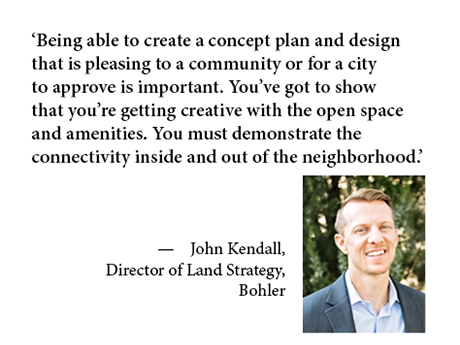The build-to-rent (BTR) property type has gained significant traction in the commercial real estate market due to increasing interest from tenants, investors and developers. Developers moving into the BTR market before 2020 originally focused on this sector as an “in between” product for future home buyers who weren’t ready to commit to a single location but wanted additional space and amenities.
The pandemic fueled tenants’ desires for more privacy and space without the long-term commitment of homeownership, which ignited growth in the sector. As costs for single-family homes continue to rise, the BTR niche also increasingly attracts would-be homeowners who are priced out of the homebuying market — and the growing demand for BTR properties draws the attention of more and more investors and developers.
But not all stakeholders are immediately on board with development of BTR properties. The concept is rather new in some markets and local communities have questions about the zoning and operation of these hybrid communities, which are an intriguing mix of single-family concept and multifamily operations.
Developers often need to educate municipalities about the BTR concept — and they need to plan BTR properties that work for the local community. This is where Bohler — a land development design and consulting firm that helps secure entitlements and approvals — steps in to help developers create projects with the local community’s needs in mind.
Entitlements: Existing Zoning for a New Concept
Bohler works with land use attorneys to help educate local municipalities about single-family BTR concepts, illustrate what units will look like, and explain their positive impact on the community. The team then collaborates with the attorneys to apply the correct codes to allow projects to move forward. In most cases, the attorneys and Bohler are working together to apply existing code to this relatively new product type; very occasionally they wind up rewriting code to allow BTR projects to progress.
These efforts are often hyperspecialized for the communities they serve and subject to community pushback that is best addressed point by point in a manner geared towards local standards and concerns. Bohler’s approach is to work with the attorneys to determine specifics, like density, likely setbacks and other parameters to ensure these units mesh with the area standards and the municipality’s vision.
“We’ve had great success processing these types of projects through entitlements,” says John Kendall, director of land strategy at Bohler.
Addressing Concerns: Upkeep, Density and Fit in the Community
Because BTR is almost always zoned as multifamily, local municipalities want to know the details of operations and maintenance. For example, who will mow the lawn? Who will maintain the homes’ curbside appeal? Who maintains the homes’ interiors? Additionally, zoning boards and local residents often have concerns about density and the impact on local homeowners’ property values.
“There are some negative connotations that can come from multifamily because the lack of individual ownership,” says Daniel Hines, PE, principal at Bohler. “There’s a fear that tenants might not keep up their lots because they don’t own them. You have to be able to talk through that concern sometimes.”
Bohler works with property management groups to explain the responsibilities of the management groups and those of tenants. “Operations details depend on the developer and the situation of the units. Often (but not always) the property management group is maintaining everything right up to the perimeter of the building and including the exterior of the building, like they would in a traditional multifamily community,” Hines explains.
Confusion about the nature of the units can create local unease that these units will function like single-family homes or high-density housing rather than BTR’s typical role as a multifamily alternative.
Kendall notes, “You’re educating a city (often multiple times over) about this new product. It takes a lot of finesse and resources to put it all together.”
He adds, “Being able to create a concept plan and design that is pleasing to a community or for a city to approve is important. You’ve got to show that you’re getting creative with the open space and amenities. You must demonstrate the connectivity inside and out of the neighborhood.”
Fitting in with a Community and Local Trends
According to Kendall, onboarding cities for BTR as a concept can be as simple as outlining how these units fit into an already existing ecosystem of housing — as a space between an apartment building and buying a house — with amenities, comfort and privacy but without the commitment or cost of buying a home outright.
He notes that local trends and needs are paramount. Developers must consider the local community when planning number of stories, appearance, price and more. And they must understand local concerns in order to surmount zoning issues.
For example, Kendall references zoning for BTR in Texas. “Planned development and single-family spaces for rent allow us to build anywhere from eight to 12 units to the acre. We need to be very specific in our plan, saying we will only build up to 12 units to the acre. This means Texas cities are not threatened by multifamily zoning where we could hypothetically change our plan to build higher density.”
Working with another specific BTR developer, Bohler has assisted in creating design specifications and standards to be applied across all markets moving forward. By standardizing community designs, the team has identified efficiencies in the development process as well as the process of seeking entitlements and approvals.
Bohler’s work is an on-going effort to complete due diligence, determine appropriate sites and harmonize with local jurisdictions to streamline entitlements.
— By Sarah Daniels. Bohler is a content partner of REBusinessOnline. For more articles from and news about Bohler, click here.



